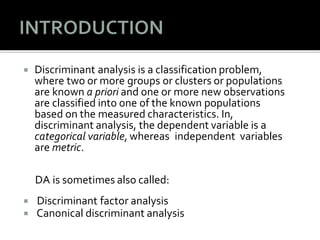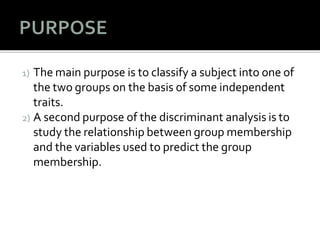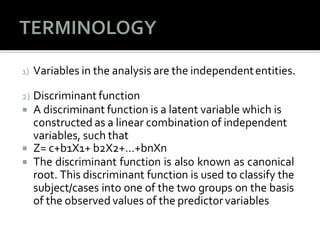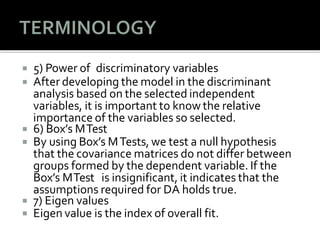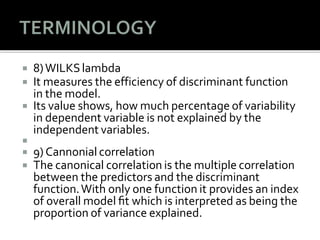discriminant analysis.pdf
- 2. ’éĪ Discriminant analysis is a classification problem, where two or more groups or clusters or populations are known a priori and one or more new observations are classified into one of the known populations based on the measured characteristics. In, discriminant analysis, the dependent variable is a categorical variable, whereas independent variables are metric. DA is sometimes also called: ’éĪ Discriminant factor analysis ’éĪ Canonical discriminant analysis
- 3. 1) The main purpose is to classify a subject into one of the two groups on the basis of some independent traits. 2) A second purpose of the discriminant analysis is to study the relationship between group membership and the variables used to predict the group membership.
- 4. ’éĪ Development of discriminant functions ’éĪ Examination of whether significant differences exist among the groups, in terms of the predictor variables. ’éĪ Determination of which predictor variables contribute to most of the intergroup differences ’éĪ Evaluation of the accuracy of classification
- 5. ’éĪ Toidentify the characteristics on the basis of which one can classify an individual as- 1. Basket ballplayer or volleyball player on the basis of anthropometric variables. 2. High or low performer on the basis of skill. 3. Juniors or seniors category on the basis of the maturity parameters.
- 6. 1. Sample size ’éĪ group sizes of the dependent should not be grossly different i.e. 80:20, here logistic regression may be prefer. ’éĪ should be at least five times the number of independent variables. 2. Normal distribution ’éĪ Each of the independent variable is normally distributed.
- 7. 3. Homogeneity of variances / covariance ’éĪ All variables have linear relationships. 4.Outliers ’éĪ Outliers should not be present in the data. DA is highly sensitive to the inclusion of outliers. 5. Mutually exclusive ’éĪ The groups must be mutually exclusive, with every subject or case belonging to only one group.
- 8. 6.Classification ’éĪ Each of the allocations for the dependent categories in the initial classi’¼ücation are correctly classi’¼üed. 7.Variability ’éĪ No independent variables should have a zero variability in either of the groups formed by the dependent variable.
- 9. 1) Variables in the analysis are the independententities. 2) Discriminant function ’éĪ A discriminant function is a latent variable which is constructed as a linear combination of independent variables, such that ’éĪ Z= c+b1X1+ b2X2+ŌĆ”+bnXn ’éĪ The discriminant function is also known as canonical root. This discriminant function is used to classify the subject/cases into one of the two groups on the basis of the observed values of the predictorvariables
- 10. ’éĪ 3) Classification matrix ’éĪ In DA, it serves as a yardstick in measuring the accuracy of a model in classifying an individual /case into one of the two groups. It is also known as confusion matrix, assignment matrix, or prediction matrix. It tells us as to what percentage of the existing data points are correctly classified by the model developed in DA. ’éĪ 4) Stepwise method of discriminant analysis ’éĪ Discriminant function can be developed either by entering all independent variables together or in stepwise depending upon whether the study is confirmatory or exploratory.
- 11. ’éĪ 5) Power of discriminatory variables ’éĪ After developing the model in the discriminant analysis based on the selected independent variables, it is important to know the relative importance of the variables so selected. ’éĪ 6) BoxŌĆÖs MTest ’éĪ By using BoxŌĆÖs MTests, we test a null hypothesis that the covariance matrices do not differ between groups formed by the dependent variable. If the BoxŌĆÖs MTest is insignificant, it indicates that the assumptions required for DA holds true. ’éĪ 7) Eigen values ’éĪ Eigen value is the index of overall fit.
- 12. ’éĪ 8)WILKSlambda ’éĪ It measures the efficiency of discriminant function in the model. ’éĪ Its value shows, how much percentage of variability in dependent variable is not explained by the independent variables. ’éĪ ’éĪ 9) Cannonial correlation ’éĪ The canonical correlation is the multiple correlation between the predictors and the discriminant function.With only one function it provides an index of overall model ’¼üt which is interpreted as being the proportion of variance explained.
- 13. ’é¦ STEP1. In step one the independent variables which have the discriminating power are being chosen. ’é¦ STEP2. A discriminant function model is developed by using the coefficients of independent variables
- 14. ’éĪ STEP3. In step three WilkŌĆÖs lambda is computed for testing the significance of discriminant function. ’éĪ STEP4. In step four the independent variables which possess importance in discriminating the groups are being found.
- 16. ’éĪ QUESTION - TO IDENTIFYA PLAYER INTO DIFFERENTCATAGORIES DURINGTHE SELECTION PROCESS INA CRICKETTRAINING CAMP
- 23. OUTPUT FOR SPSS
- 27. Øæŗ1 Height Øæŗ2 Back explosive power Øæŗ3 Judgement Øæŗ4 Patience Z= -24.880 + .169 ├Ś Øæ┐ؤÅ+ .466├Ś Øæ┐ؤÉ- .423 ├Ś Øæ┐ؤæ- .204 ├Ś Øæ┐ؤÆ


